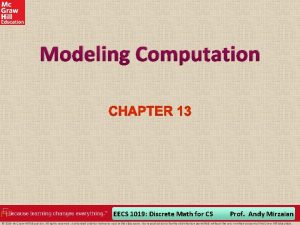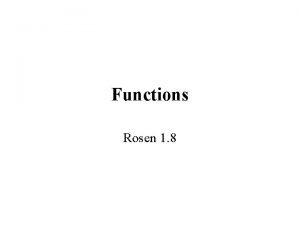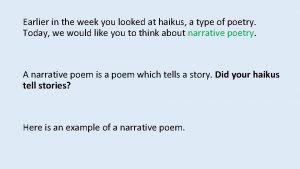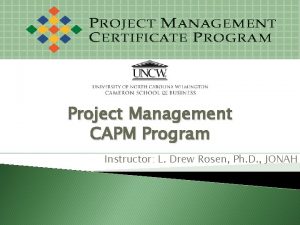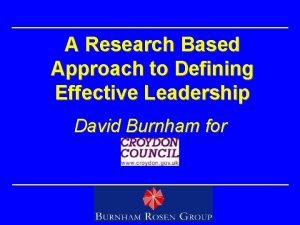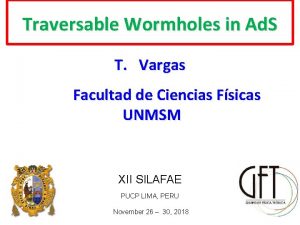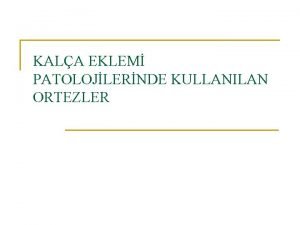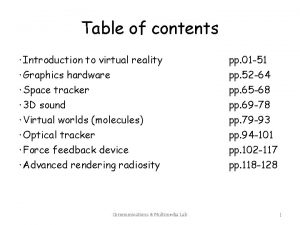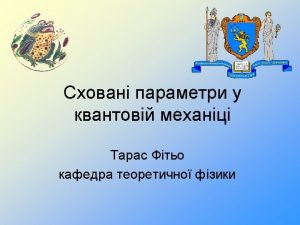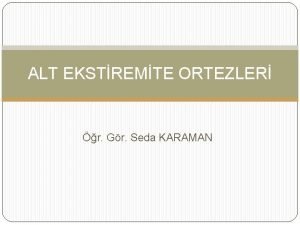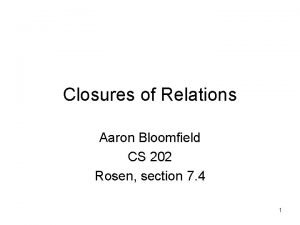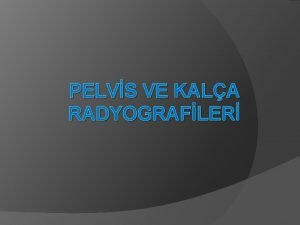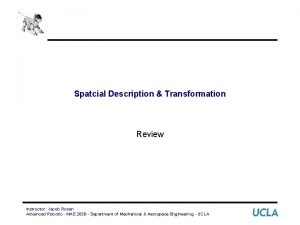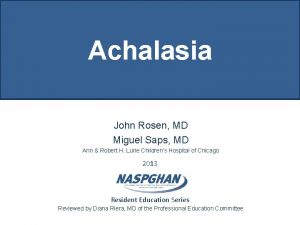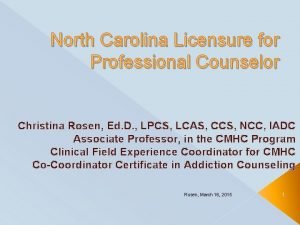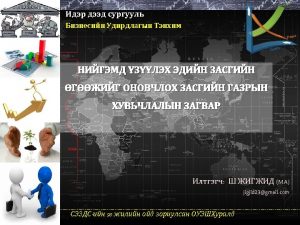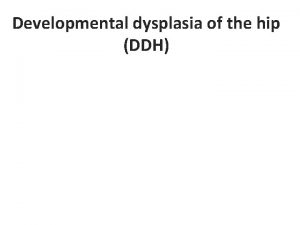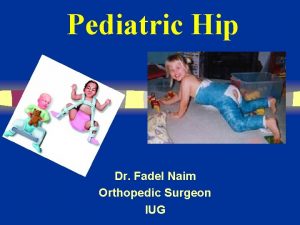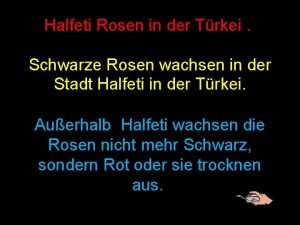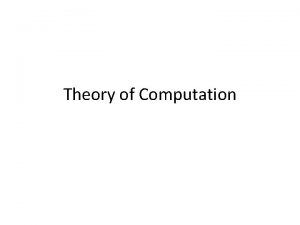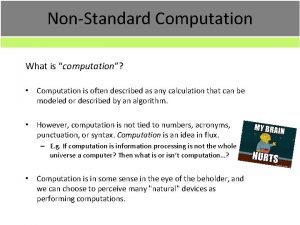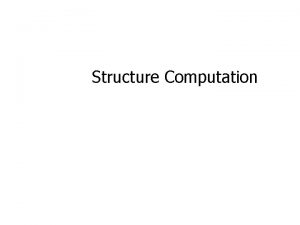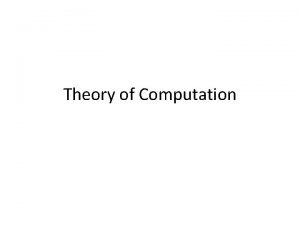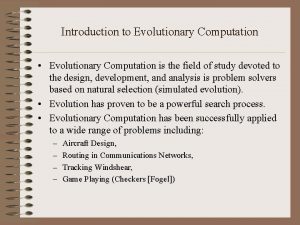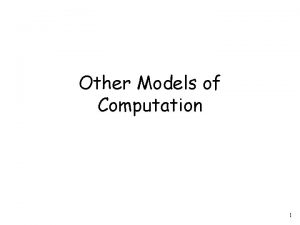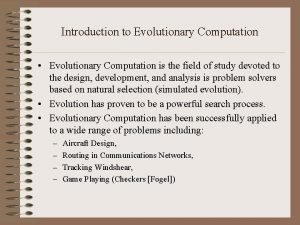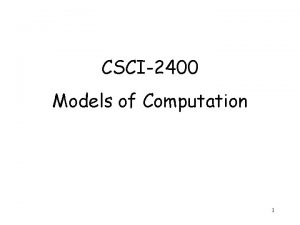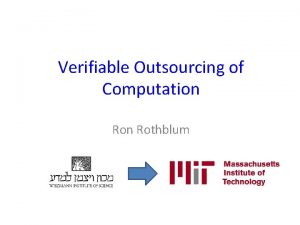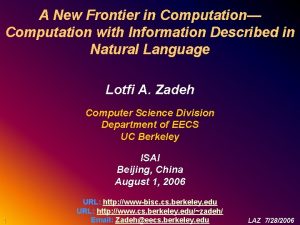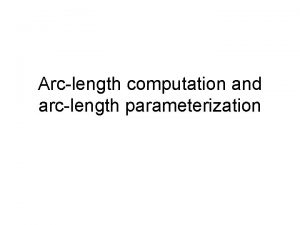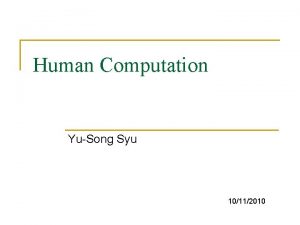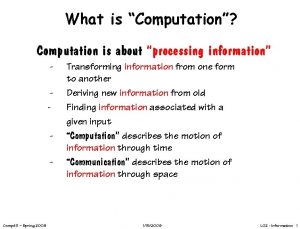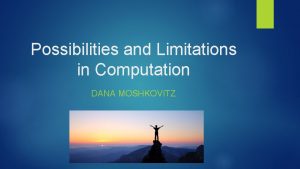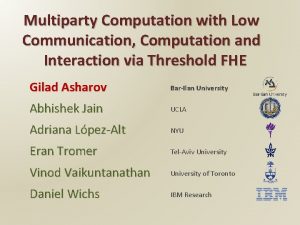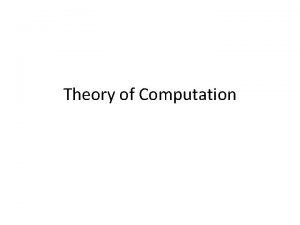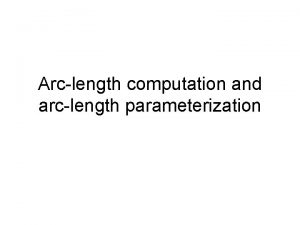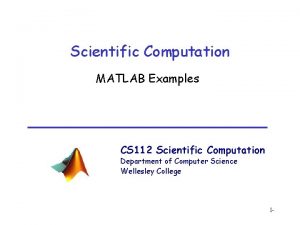Modeling Computation Rosen ch 12 Modeling Computation We


























- Slides: 26

Modeling Computation Rosen, ch. 12

Modeling Computation • We learned earlier the concept of an algorithm. – A description of a computational procedure. • Now, how can we model the computer itself, and what it is doing when it carries out an algorithm? – For this, we want to model the abstract process of computation itself.

Early Models of Computation • Recursive Function Theory – Kleene, Church, Turing, Post, 1930’s (before computers!!) • Turing Machines – Turing, 1940’s (defined: computable) • RAM Machines – von Neumann, 1940’s (“real computer”) • Cellular Automata – von Neumann, 1950’s (Wolfram 2005; physics of our world? ) • Finite-state machines, pushdown automata – various people, 1950’s • VLSI models – 1970 s • Parallel RAMs, etc. – 1980’s

§ 12. 1 – Languages & Grammars • • Phrase-Structure Grammars Types of Phrase-Structure Grammars Derivation Trees Backus-Naur Form

Computers as Transition Functions • A computer (or really any physical system) can be modeled as having, at any given time, a specific state s S from some (finite or infinite) state space S. • Also, at any time, the computer receives an input symbol i I and produces an output symbol o O. – Where I and O are sets of symbols. • Each “symbol” can encode an arbitrary amount of data. • A computer can then be modeled as simply being a transition function T: S×I → S×O. – Given the old state, and the input, this tells us what the computer’s new state and its output will be a moment later. • Every model of computing we’ll discuss can be viewed as just being some special case of this general picture.

Language Recognition Problem • Let a language L be any set of some arbitrary objects s which will be dubbed “sentences. ” – “legal” or “grammatically correct” sentences of the language. • Let the language recognition problem for L be: – Given a sentence s, is it a legal sentence of the language L? • That is, is s L? • Surprisingly, this simple problem is as general as our very notion of computation itself! Hmm… • Ex: addition ‘language’ “num 1 -num 2 -(num 1+num 2)”

Vocabularies and Sentences • Remember the concept of strings w of symbols s chosen from an alphabet Σ – An alternative terminology for this concept: • Sentences σ of words υ chosen from a vocabulary V. – No essential difference in concept or notation! • Empty sentence (or string): λ (length 0) • Set of all sentences over V: Denoted V*.

Grammars • A formal grammar G is any compact, precise mathematical definition of a language L. – As opposed to just a raw listing of all of the language’s legal sentences, or just examples of them. • A grammar implies an algorithm that would generate all legal sentences of the language. – Often, it takes the form of a set of recursive definitions. • A popular way to specify a grammar recursively is to specify it as a phrase-structure grammar.

Phrase-Structure Grammars • A phrase-structure grammar (abbr. PSG) G = (V, T, S, P) is a 4 -tuple, in which: – V is a vocabulary (set of words) • The “template vocabulary” of the language. – T V is a set of words called terminals • • Actual words of the language. Also, N : ≡ V − T is a set of special “words” called nonterminals. (Representing concepts like “noun”) – S N is a special nonterminal, the start symbol. – P is a set of productions (to be defined). • Rules for substituting one sentence fragment for another. A phrase-structure grammar is a special case of the more general concept of a string-rewriting system, due to Post.

Productions • A production p P is a pair p=(b, a) of sentence fragments a, b (not necessarily in L), which may generally contain a mix of both terminals and nonterminals. – We often denote the production as b → a. • Read “replace b by a” – Call b the “before” string, a goes the “after” string. – It is a kind of recursive definition meaning that If lbr LT, then lar LT. (LT = sentence “templates”) • That is, if lbr is a legal sentence template, then so is lar. • That is, we can substitute a in place of b in any sentence template.

Languages from PSGs • The recursive definition of the language L defined by the PSG: G = (V, T, S, P): Abbreviate – Rule 1: S LT (LT is L’s template language) – this using • The start symbol is a sentence template (member of LT). lbr lar. (read, “lar is Rule 2: directly T T (b→a) P: l, r V*: lbr L → lar L derivable • Any production, after substituting in any fragment of any from lbr”). sentence template, yields another sentence template. – Rule 3: ( σ LT: ¬ n N: n σ) → σ L • All sentence templates that contain no nonterminal symbols are sentences in L.

PSG Example – English Fragment We have G = (V, T, S, P), where: • V = {(sentence), (noun phrase), (verb phrase), (article), (adjective), (noun), (verb), (adverb), a, the, large, hungry, rabbit, mathematician, eats, hops, quickly, wildly} • T = {a, the, large, hungry, rabbit, mathematician, eats, hops, quickly, wildly} • S = (sentence) • P = (see next slide)

Productions for our Language P = { (sentence) → (noun phrase) (verb phrase), (noun phrase) → (article) (adjective) (noun), (noun phrase) → (article) (noun), (verb phrase) → (verb) (adverb), (verb phrase) → (verb), (article) → a, (article) → the, (adjective) → large, (adjective) → hungry, (noun) → rabbit, (noun) → mathematician, (verb) → eats, (verb) → hops, (adverb) → quickly, (adverb) → wildly }

Backus-Naur Form sentence : : = noun phrase verb phrase noun phrase : : = article [ adjective ] noun verb phrase : : = verb [ adverb ] article : : = a | the Square brackets [] mean “optional” adjective : : = large | hungry noun : : = rabbit | mathematician Vertical bars verb : : = eats | hops mean “alternatives” adverb : : = quickly | wildly

A Sample Sentence Derivation (sentence) (noun phrase) (verb phrase) (article) (adj. ) (noun) (verb phrase) (art. ) (adj. ) (noun) (verb) (adverb) the (adj. ) (noun) (verb) (adverb) the large rabbit (verb) (adverb) the large rabbit hops (adverb) the large rabbit hops quickly On each step, we apply a production to a fragment of the previous sentence template to get a new sentence template. Finally, we end up with a sequence of terminals (real words), that is, a sentence of our language L.

Another Example V T • Let G = ({a, b, A, B, S}, {a, b}, S, P {S → ABa, A → BB, B → ab, AB → b}). • One possible derivation in this grammar is: S ABa Aaba BBaba Bababa abababa.

Derivability • Recall that the notation w 0 w 1 means that (b→a) P: l, r V*: w 0 = lbr w 1 = lar. – The template w 1 is directly derivable from w 0. • If w 2, …wn-1: w 0 w 1 w 2 … wn, then we write w 0 * wn, and say that wn is derivable from w 0. – The sequence of steps wi wi+1 is called a derivation of wn from w 0. • Note that the relation * is just the transitive closure of the relation .

A Simple Definition of L(G) • The language L(G) (or just L) that is generated by a given phrase-structure grammar G=(V, T, S, P) can be defined by: L(G) = {w T* | S * w} • That is, L is simply the set of strings of terminals that are derivable from the start symbol.

Generating Infinite Languages • A simple PSG can easily generate an infinite language. • Example: S → 11 S, S → 0 (T = {0, 1}). • The derivations are: – S 0 – S 11 S 1111 S 11110 – and so on… L = {(11)*0} – the set of all strings consisting of some number of concatenations of 11 with itself, followed by 0.

Another example • Construct a PSG that generates the language L = {0 n 1 n | n N}. – 0 and 1 here represent symbols being concatenated n times, not integers being raised to the nth power. • Solution strategy: Each step of the derivation should preserve the invariant that the number of 0’s = the number of 1’s in the template so far, and all 0’s come before all 1’s. • Solution: S → 0 S 1, S → λ.

Types of Grammars Chomsky hierarchy of languages • Venn Diagram of Grammar Types: Type 0 – Phrase-structure Grammars Type 1 – Context-Sensitive Type 2 – Context-Free Type 3 – Regular

Defining the PSG Types • Type 1: Context-Sensitive PSG: – All after fragments are either longer than the corresponding before fragments, or empty: if b → a, then |b| < |a| a = λ. • Type 2: Context-Free PSG: – All before fragments have length 1: if b → a, then |b| = 1 (b N). • Type 3: Regular PSGs: – All after fragments are either single terminals, or a pair of a terminal followed by a nonterminal. if b → a, then a T a TN.

Classifying grammars Given a grammar, we need to be able to find the smallest class in which it belongs. This can be determined by answering three questions: Are the left hand sides of all of the productions single non-terminals? • If yes, does each of the productions create at most one non-terminal and is it on the right? Yes – regular No – context-free • If not, can any of the rules reduce the length of a string of terminals and non-terminals? Yes – unrestricted No – context-sensitive

Definition: Context-Free Grammars Grammar Variables Terminal symbols Start variable Productions of the form: Variable String of variables and terminals

Example The language { anbncn | n 1} is context-sensitive but not context free. A grammar for this language is given by: S a. SBC | a. BC CB BC a. B ab b. B bb b. C bc c. C cc

A derivation from this grammar is: S a. SBC aa. BCBC (using S a. BC) aab. CBC (using a. B ab) aab. BCC (using CB BC) aabb. CC (using b. B bb) aabbc. C (using b. C bc) aabbcc (using c. C cc) which derives a 2 b 2 c 2.
 Rot rot rot sind die rosen rosen die ich an dich verschenke
Rot rot rot sind die rosen rosen die ich an dich verschenke Eddie rosen brian rosen
Eddie rosen brian rosen Modeling computation discrete math
Modeling computation discrete math Model and role modeling theory
Model and role modeling theory Dimensional modeling vs relational modeling
Dimensional modeling vs relational modeling What is one one and onto function
What is one one and onto function Walter g. rosen
Walter g. rosen The car trip michael rosen
The car trip michael rosen Drew rosen
Drew rosen Burnham rosen group
Burnham rosen group Bryant triangle normal range
Bryant triangle normal range Eaton-rosen phenomenon
Eaton-rosen phenomenon Gao jafferis wall
Gao jafferis wall Lateral fleksiyon
Lateral fleksiyon David rosen sega
David rosen sega Epr einstein podolsky rosen
Epr einstein podolsky rosen Von rosen cihazı
Von rosen cihazı Aaron bloomfield
Aaron bloomfield Ap pelvis grafisi
Ap pelvis grafisi Homogeneous transform
Homogeneous transform John rosen
John rosen Christina rosen
Christina rosen Mussa rosen
Mussa rosen Rosenmath
Rosenmath Alpha and beta angles in ddh
Alpha and beta angles in ddh Travel recount
Travel recount Frejka pillow
Frejka pillow


